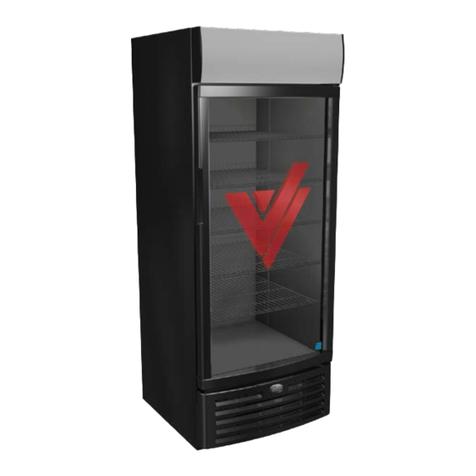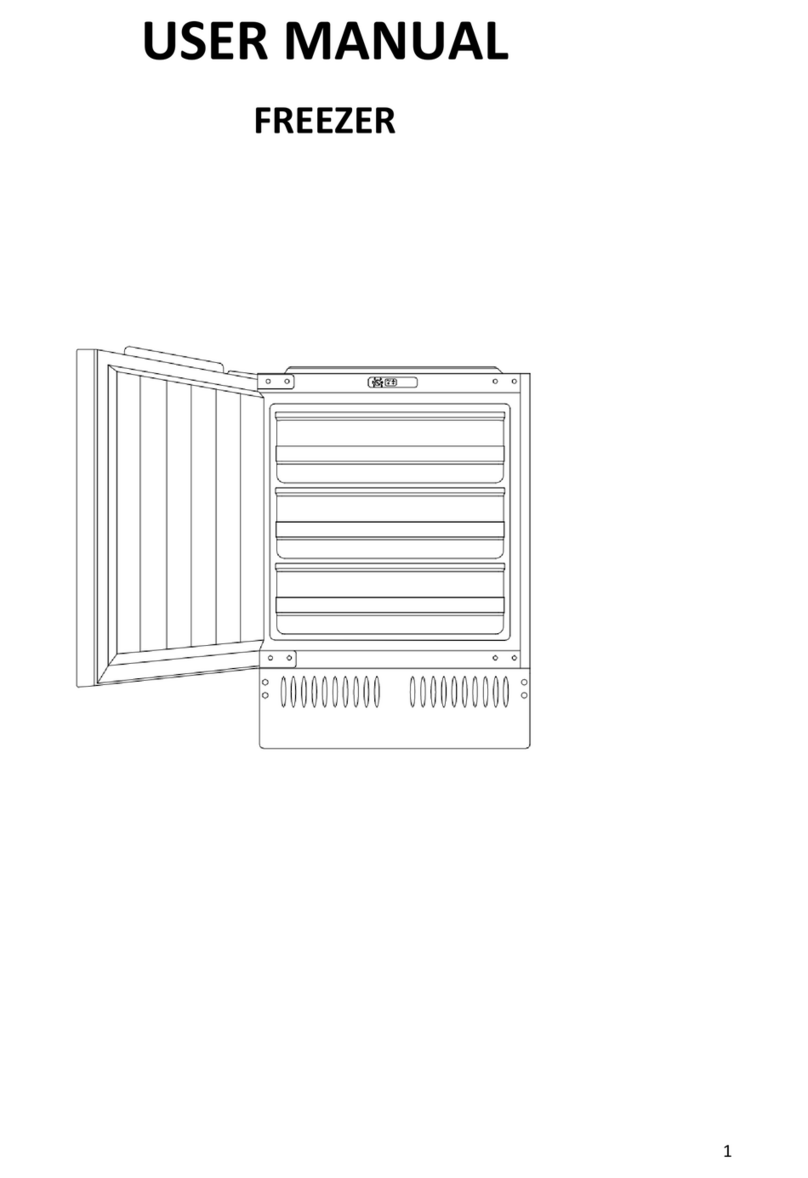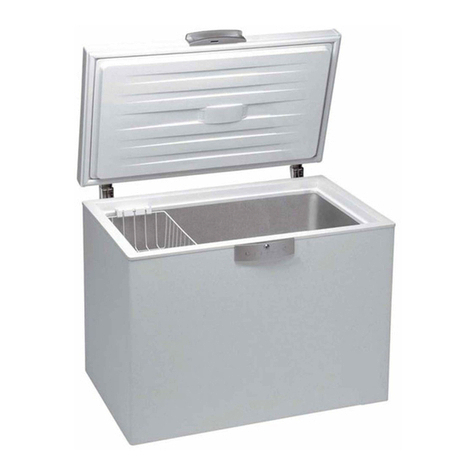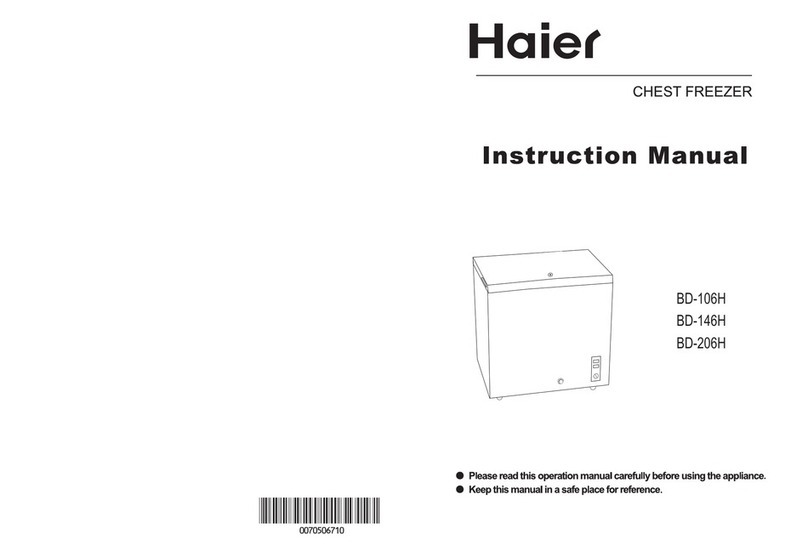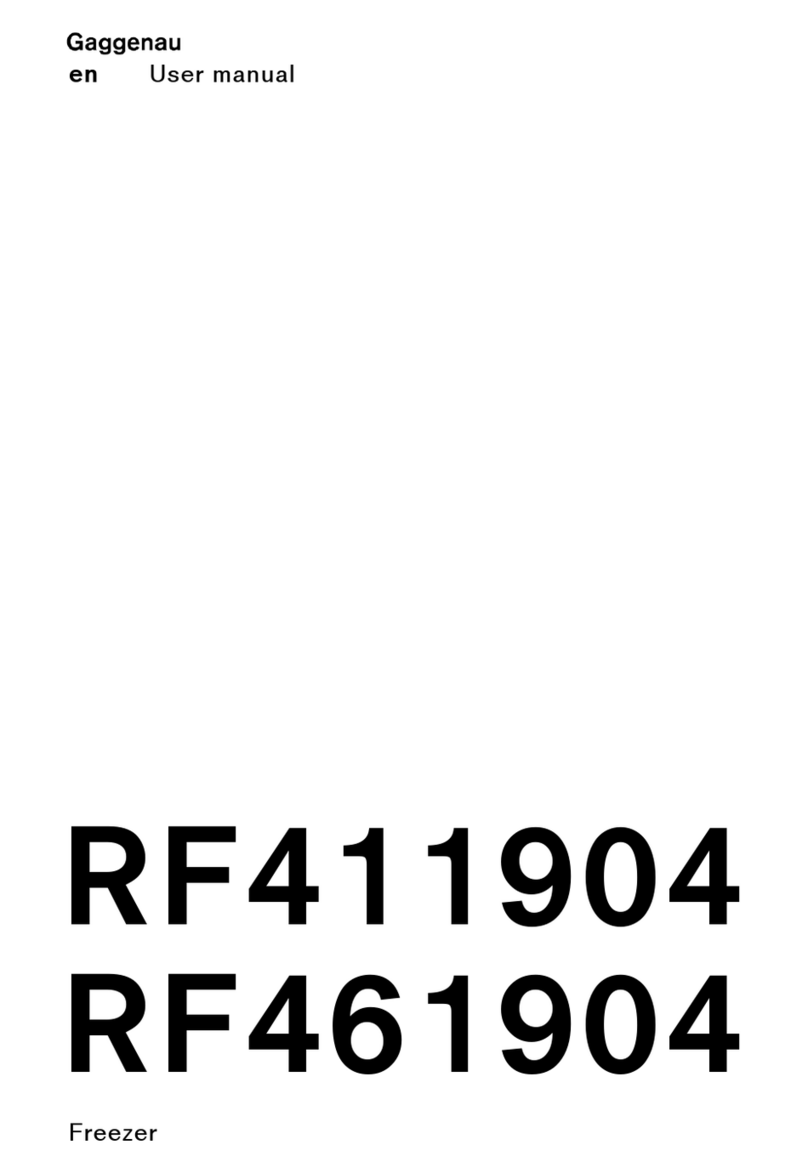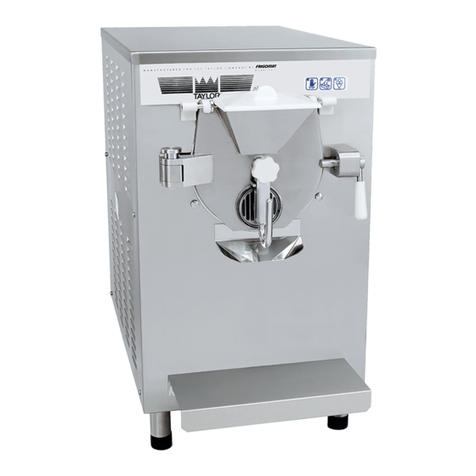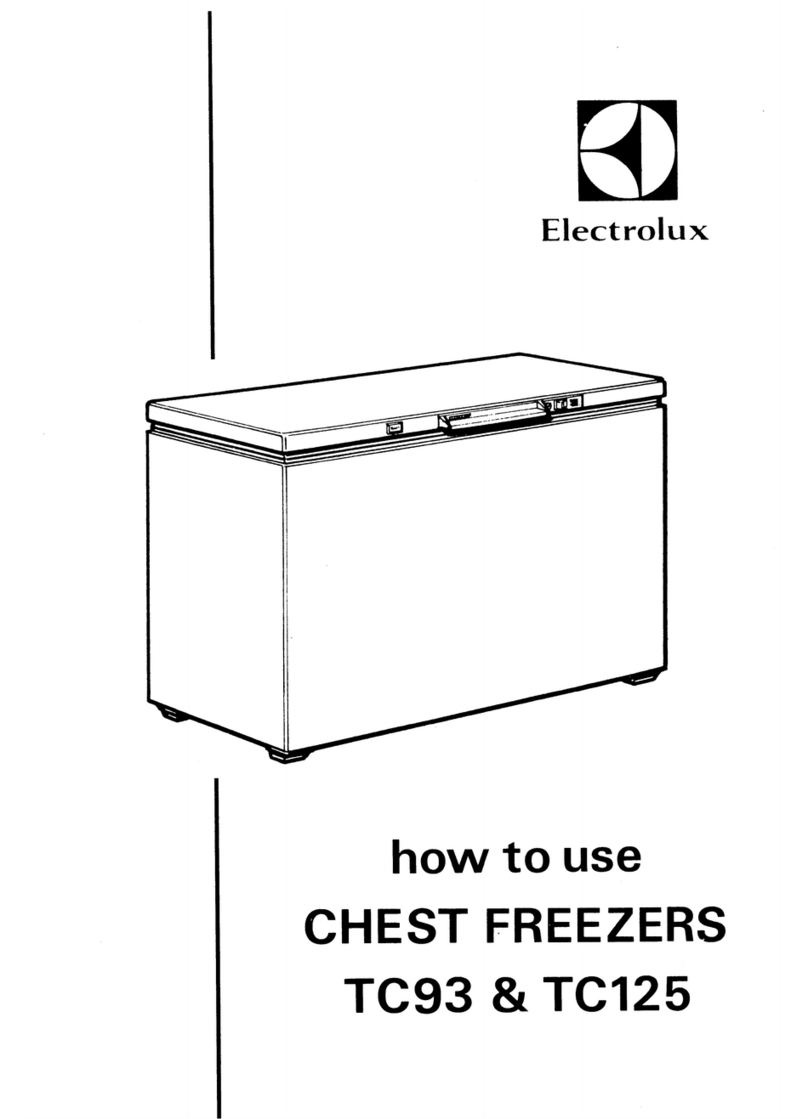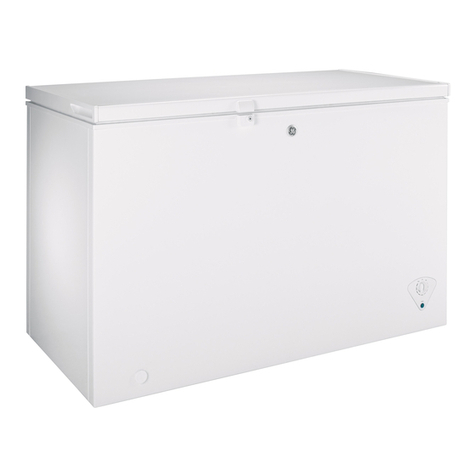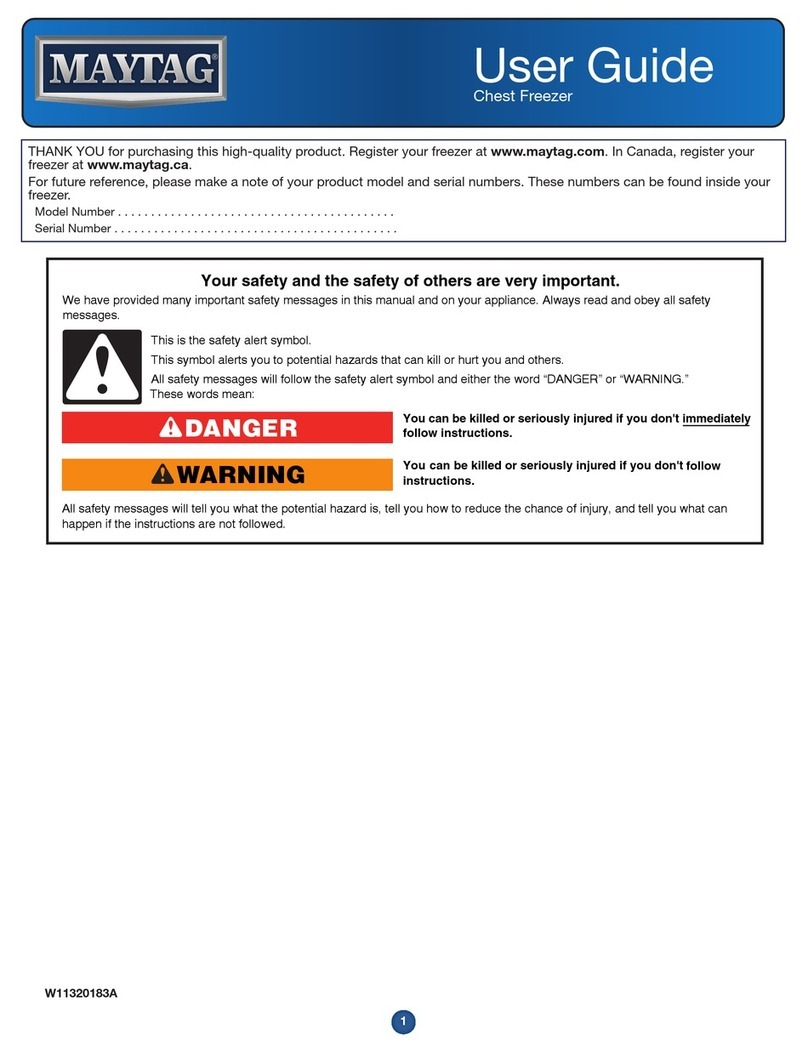Precision PCF15 User manual

OPERATING INSTRUCTIONS:
BLAST CHILLER / FREEZER
PCF15 - PCF40 - PCF50
Precision Refrigeration Limited - Stephenson Way, Thetford, Norfolk, IP24 3RU, UK
+44 (0)1842 753994 - sales@precision-refrigeration.com

Contents
General Hazards
3
Electrical Connection
3
Unpacking
3
Installation
3
Ventilation
3
Shelves / Pans / Slides
4
Castors / Adjustable Legs / Levelling Feet
4
Initial Start Up
4
Checks
4
Using Your New Blast Chiller / Freezer
4
Using your Blast Chiller / Freezer: Operation Modes / Product Loading / Starting a Cycle
5 - 7
Settings
8
Changing Default Cycle Settings
8
Changing System Settings
8
Alarms
9
Engineer’s Settings
9
Maintenance and Cleaning: Condenser, Gasket Replacement
9 - 10
End of Life Disposal Requirements
10
Notes
11
All details are subject to change without prior notice.

- 3 -
General Hazards
All moving parts of the Blast Chiller are suitably guarded, and the moving parts can only be
accessed by using tools which should only be attempted by a qualified person.
Electrical Connection
PCF15 & PCF40 is supplied with a molded 13 Amp plug which needs a suitable socket.
PCF50 requires dedicated 16 Amp supply. This cabinet should not be used outside and
should be used in a dry environment. The plug needs to be accessible once the equipment
is placed in its final position. Should the plug need changing, this must be done by a
qualified person.
Unpacking
Leave all packaging in place until blast chiller is in its final position to avoid damage. When
the cabinet is in its final position, carefully remove all packaging and check for damage.
Any damage should be reported immediately to your dealer. All packaging should be
carefully disposed of and recycled where possible.
Installation
The cabinet is very easy to move around as precision blast chillers are supplied on castors
as standard. If for any reason the cabinet has to be laid down, it should always be laid on
its back and not its side or front to avoid damage. When lowering or raising the cabinet
extreme care should be taken as the castors can run away whilst lifting or lowering. A
person should always be standing at the base of the cabinet whilst it is being lowered or
raised. Cabinet should not be plugged in for at least 1 hour if it has been laid down or
tipped during installation.
This product must be placed on a level floor to ensure the automatic door closing and
correct draining of condensate.
Ventilation
Refrigeration equipment, and Blast Chillers in particular, generates a lot of heat. A Blast
Chiller gives off the same heat as a large electric heater. Therefore, it is very important
that it must be installed with sufficient space around it for ventilation and for maintenance
access. Ventilation grills must not be blocked, or even partially blocked as this could affect
the cabinetʼs performance and life span.

- 4 -
Shelves / Pans / Slides
Fit the shelf / pan slides in the correct position to suit the user.
Gastronorm pans are not supplied as standard.
Castors / Adjustable Legs / Levelling Feet
Lock the two front castors once the cabinet is in its final position by
pressing down the metal bar with your foot. This will stop the
cabinet from moving when the door is opened and closed. The level
on models fitted with castors canʼt be adjusted so a level floor
should be provided. Models fitted with adjustable legs or levelling
feet can be levelled by screwing the legs/feet in or out to the
desired height.
Initial Start Up
Make sure unit is connected to appropriate power socket. Press and hold standby button
to turn on the Blast Chiller will automatically go into Chill Store mode.
Checks
After initial startup, the Blast Chiller / Freezer should start to pull down to the preset
temperature, check that the temperature is reducing and listen inside and outside the
cabinet to make sure the fans are turning freely to check there has been no movement in
shipping. If time permits, stay with the cabinet until the preset temperature is reached and
the condensing unit cuts out.
Using Your New Blast Chiller / Freezer
The cabinet must reach its preset operating temperature before loading any produce.
Please ensure that the produce is equally distributed throughout the cabinet and that air
can circulate around and through the products stored.

- 5 -
Operation Modes
Precision Blast Chiller / Freezers have the following operation modes:
Soft Chill – Blast Chill Food to 3ºC - For Delicate, Less Dense Food Products
Hard Chill – Blast Chill Food to 3ºC - For Thicker Food Products & Sauces
Freeze – Blast Freeze Food to -18ºC - For All Products
Chill Store – Chilled Storage 1 / 4ºC - Storage of Chilled Food
Freeze Store – Freezer Storage -18 / -22ºC - Storage of Frozen Food
Thaw – Controlled Defrosting of Frozen Food Products
Product Loading
Food should be loaded into Gastronorm pans which slide directly onto the Blast Chillerʼs
shelving system. Remember that a Blast Chiller works in a very similar way to an oven, but
in reverse. An oven puts heat into the food and a Blast Chiller takes heat out. With this in
mind, some products chill faster than others and there is a possibility for some items to
freeze on the exterior if left in the Blast Chiller for too long, as they might burn on the
exterior if left in an oven for too long.
Starting a cycle
Press your desired operational mode. For all Chill, Freeze or Thaw cycles, you will then be
given the option of choosing a pre-set cycle termination method of time and/or food probe
temperature. Press your required option to start the cycle. You can modify the default time
or temperature by pressing and holding your desired option. Please note: Any changes
made here will revert to factory default time or temperature setting for the next cycle.
Factory default times & temperatures can be modified in “Settings” - see page 8.

- 6 -
During a Cycle
Once a cycle has started, the screen shows remaining time on a time cycle or food probe
on a probe controlled cycle.
Press to edit a cycle midstream and modify cycle duration time or food probe
termination temperature.
Press for information mid cycle:
Press to cancel cycle and OK to confirm:

- 7 -
End of Cycle
Buzzer Sounds & Completed Screen Shows Indicating Cycle Is Complete. Touch Screen
To Clear.
Appropriate Chill or Freeze Storage Mode Starts Automatically Once Chill, Freeze or Thaw
Cycle Terminates.
Storage Mode Will Continue Indefinitely Until Cancelled.

- 8 -
Settings Screen
Press to enter settings. Please note, icons turn dark blue in settings mode.
Changing Default Cycle Settings:
Press any button to adjust desired default cycle settings
Press any setting to change parameter
Changing System Settings:
Press to change system settings Press any setting to change parameter.

- 9 -
Alarms:
Press to see details of any recent errors
Engineer Settings:
Press to access engineering mode to modify any setting. Please note this area is
password protected for engineer’s use only. Contact factory for password.
Maintenance
The Blast Chiller / Freezer is fully automatic and, apart from cleaning needs very little
maintenance.
Interior and exterior should be cleaned with soap and water and no abrasives should be
used as they will scratch and spoil the stainless steel finish. Interior shelving and racking
can be removed for easy cleaning.
Maintenance and Cleaning
Before cleaning and maintenance, the cabinet should be in standby mode then unplugged
from the power supply.
Door Gaskets should be cleaned with warm soapy water and inspected on a regular basis
and if damaged they should be replaced. Cooking oils and harsh cleaning detergents will
shorten the life of the gaskets and contact should be avoided.

- 10 -
Condenser Cleaning
All the heat removed from the Blast Chiller / Freezer is discharged into the room via the
condenser which is similar to a car radiator. This must be kept clean so that the air can
pass through it to remove the heat, if it becomes choked with dust the unit will overheat
and this can lead to a burnt-out compressor. The condenser should be brushed with a soft
brush to remove any dust deposited on the alloy fins. Ensure the machine is turned off
when doing this to prevent dirt being sucked deeper into the condenser. The frequency of
this cleaning is determined by the amount of dust in the surrounding area but should be
cleaned at least 4 times a year.
Gasket Replacement
Damaged gaskets can easily be replaced. Remove the old
gasket by gently pulling it out of the gasket retainer and simply
push in the new gasket leaving the corners until last.
End of Life Disposable Requirements
Refrigerated cabinets have components that could be harmful to the environment. All end
of life equipment must be disposed of in accordance with national laws and regulations.
Fault Finding
In the event of cabinet fault/failure, please check the following:
1.
Plug is in socket and power to the socket can be proven by plugging another appliance
into the same socket or swapping the problem cabinet to a socket that is known to
work.
2.
The fuse located in the plug is intact.
3.
The condenser is clean and free from dust or debris.
4.
Door gasket is sealing and free from damage.
If this doesn’t solve the problem, please call a qualified technician.
When requesting a service call, please find the manufacturers data plate and provide the
model, serial number and details of any fault codes that are displayed.

- 11 -
Notes:
______________________________________________________________________________
______________________________________________________________________________
______________________________________________________________________________
______________________________________________________________________________
______________________________________________________________________________
______________________________________________________________________________
______________________________________________________________________________
______________________________________________________________________________
______________________________________________________________________________
______________________________________________________________________________
______________________________________________________________________________
______________________________________________________________________________
______________________________________________________________________________
______________________________________________________________________________
______________________________________________________________________________
______________________________________________________________________________
______________________________________________________________________________
______________________________________________________________________________
______________________________________________________________________________
______________________________________________________________________________

- 12 -
Model: …………………………………………………………………….
Serial Number: ………………………………………………………..
GWP Values for Refrigerants:
R290 - 3
R134a – 1300
R452A – 2140
These units contain fluorinated greenhouse gases covered by the F Gas directive
Declaration of Conformity References:
Low Voltage Directive 2006/95/EC
EC Machinery Directive 2006/42EC
Electromagnetic Compatibility Directive 2004/108/EC
Pressure Equipment Directive 97/23/EC
RoHS / WEE Directive 2002/95 EC
Model /
Modèle: ...............................................................................
Serial Number /
Numéro de Série:.................................................................
Declaration of Conformity References:
Low Voltage Directive 2006/95/EC
EC Machinery Directive 98/37/EC
Electromagnetic Compatibility Directive 2004/108/EC
Pressure Equipment Directive 97/23/EC
Déclaration de Conformité du Fabricant:
Directive 2006/95/EC relative à la Basse Tension
Directive 98/37/EC relative aux Machines Directive
2004/108/EC relative à la Compatibilite Electronmagnetique
Directive 97/23/EC relative à l’Equipment Pressurise
GWP Values for HFC R134a and R404a refrigerants:
R404a – !3800 (CO2 = 1)
R134a – 1300 !(CO2 = 1)
These units contain fluorinated greenhouse gases covered by the F Gas directive
Precision Refrigeration Limited - Stephenson Way, Thetford, Norfolk, IP24 3RU, UK
+44 (0)1842 753994 - sales@precision-refrigeration.com
This manual suits for next models
2
Table of contents


